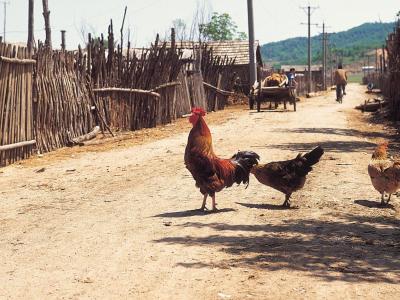Immunizing pregnant women rated as best pertussis defense for infants
Immunizing pregnant women against pertussis in each of their pregnancies, thereby conferring passive immunity on their infants, is the most effective and feasible strategy for protecting infants against the disease, says a review article published yesterday in Pediatrics.
A second strategy, "cocooning," which involves vaccinating individuals who will be in close proximity to an infant, should be used secondarily if the first is not possible, the report says. The two prevention methods have been recommended by the Global Pertussis Initiative (GPI), an international forum of experts convened in 2001 to address the global burden of pertussis, which has seen a recent resurgence.
Infants are at highest risk for serious and fatal pertussis, both those too young to be vaccinated and those older who have not been fully vaccinated. The currently available acellular pertussis vaccines provide only transient protection, with antibody titers waning rapidly after immunization, note the authors, from Australia, the United States, and Germany.
They reviewed available data on the two GPI strategies to arrive at their conclusions. A number of studies have shown a decrease in infant pertussis with rising uptake of maternal immunization as well as the safety and tolerability of such immunization for both women and neonates.
Among the noted barriers to the cocooning strategy were high cost, accessibility of the vaccine to family members, reluctance by providers of maternal care to immunize whole families, and poor compliance among families. The study authors note that "real-world data remain limited on the clinical effectiveness of vaccination against pertussis during pregnancy and of cocooning, especially in the form of large trials."
In an accompanying commentary, Mark Sawyer, MD, and Sarah S. Long, MD, whole-heartedly endorse the study's findings, saying, "We must circle the wagons around young infants." They cite statistics from California showing a decrease in infant deaths from 10 in 2010 to 3 in 2014, a time during which pertussis immunization in pregnancy increased.
They comment, "We desperately need a new pertussis vaccine," but conclude that until that time, maternal care-givers "must immediately increase their efforts to immunize during pregnancy" and should "present the immunization schedule as the standard of care rather than as an option."
May 11 Pediatrics abstract
Related May 11 commentary
Experts call for global public health R & D fund
An international group of public health leaders and researchers yesterday called for a $10 billion global research fund to develop new treatments and other tools to battle antibiotic resistance, emerging infectious diseases such as Ebola, and neglected diseases. They aired their views in a commentary in Public Library of Science Medicine. The authors are from Europe, China, India, and South Africa.
The group's call for the global fund comes at a time when experts are meeting in Geneva to hammer out a research and development roadmap to address future disease threats ahead of the World Health Assembly next week and the G7 summit in June.
Traditional market-driven research and development models have failed to deliver new tools to address emerging public health challenges, the group wrote. They added that though large multilateral funds are in place for global health delivery, there is no pooled funding mechanism to boost research and development for new tools, such as drugs, vaccines, and diagnostic tests, to manage and respond to the threats.
They suggested that the mechanism have a strong link to a group such as the World Health Organization (WHO), but more evaluation is needed to determine if it should be located within or alongside the United Nations and may depend on proposed WHO reforms. It should be financed and overseen by governments with private, philanthropic, and nongovernmental groups involved as stakeholders, the participants said.
"The devastating loss of human life from the Ebola outbreak of 2014 must not be in vain. It must prompt serious changes to our joint international systems for stimulating innovation and ensuring access to health technologies for those who need them," they wrote.
May 11 PLoS Med abstract
May 11 PLoS press release
AI strikes more farms in Israel and Taiwan, plus wild Mexican birds
Israel and Taiwan reported more highly pathogenic avian outbreaks today, with Taiwan reporting additional low-pathogenic H5N2 outbreaks, according to separate reports today to the World Organization for Animal Health (OIE). Also, Mexican officials said highly pathogenic H7N3 has been found in wild birds in Chiapas state.
The outbreak in Israel, which began May 8, involves H5N1, which was detected at a commercial turkey farm in Hafazon district, located in the northern part of the country. The virus was detected in one of the facility's five barns. Of 13,000 susceptible birds, H5N1 killed 1,000 and the remaining ones were slated for culling. The country has had several H5N1 outbreaks since the first of the year.
Meanwhile, Taiwan reported four more highly pathogenic H5N8 outbreaks and seven more involving low-pathogenic H5N2. The latest in the dozens of H5N8 outbreaks the region has reported so far this year occurred at commercial farms in Changhua, Pingtung, and Yunlin counties. The outbreaks struck chickens and geese, killing 14,908 of 129,860 susceptible birds. The remaining birds were destroyed to curb spread of the virus.
Taiwan also reported seven new low-pathogenic H5N2 outbreaks at chicken farms in Yunlin County, Tainan City, Changhua County, Taichung City, and Chiayi County. Of 147,800 susceptible birds, 69,179 deaths were reported, with the rest stamped out to control the virus.
The region's agriculture council said tests at the national lab showed that the virus is low-pathogenic, with mortality less than 75% in the chickens that were tested.
Elsewhere, Mexico reported that H7N3 has been found in eight wild birds found dead in a nature reserve called the Zapotal in the far southern part of the country. Affected birds included six chachalacas and two clay-colored thrushes. The OIE report was dated May 8 but was posted today. H7N3 has been detected on Mexican poultry farms before, as well as at other locations in North America.
May 12 OIE report on H5N1 in Israel
May 12 OIE report on H5N8 in Taiwan
May 12 OIE report on low-path H5N2 in Taiwan
May 8 OIE report on H7N3 in Mexico













